
Meterana is a genus of moths of the family Noctuidae. This genus is endemic to New Zealand.
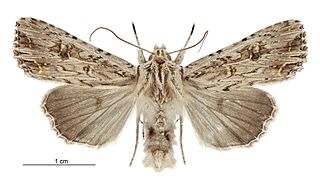
Ichneutica lignana is a moth of the family Noctuidae. It is endemic to New Zealand. This species is found on the Three Kings Islands as well as the North, South and Stewart Islands. This species lives in a variety of habitats including coastal areas, tussock grasslands, shrublands, and native forest, at a range of altitudes from sea level to over 1300 m. I. lignana is quite distinctive in appearance with its dark markings on the abdomen and forewings although it is possible to confuse Ichneutica morosa, Meterana pansicolor and Meterana pascoi with this species. Adults are on the wing throughout the year in the northern parts of the New Zealand but are restricted to the months of October to April in the more southern parts of the country.

Ichneutica insignis is a moth of the family Noctuidae. It is endemic to New Zealand. This species is found throughout New Zealand, although it appears to be scarce in inland sites of tussock grasslands. The adults are on the wing throughout the year. It is a variable species and as such can be easily confused with I. skelloni and I. plena. The larvae of this species have been recorded as feeding on Trifolium pratense.

Ichneutica plena is a moth of the family Noctuidae. It is endemic to New Zealand. It is widespread throughout the North, South and Stewart Islands. It is a variable in appearance and therefore can be confused with its near relatives I. peridotea and I. insignis. The larvae of I. plena feed on herbaceous plants including Fuchsia excorticata, Coprosma species, and introduced species such as garden fuchsia as well as crops such as apple trees. Adults of this species are on the wing from late August until May.

Dumbletonius characterifer is a species of moth of the family Hepialidae. It is endemic to New Zealand. It was first described by Francis Walker in 1865.

Declana atronivea, commonly called the North Island lichen moth or North Island zebra moth, is a moth of the family Geometridae. It is endemic to New Zealand and found only in the North Island.
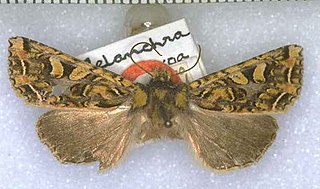
Meterana tetrachroa is a species of moth of the family Noctuidae. This species is endemic to New Zealand. It is classified as "Data Deficient" by the Department of Conservation.

Meterana pauca is a moth of the family Noctuidae. It is endemic to New Zealand. It was described by Philpott in 1910 from two specimens held at the Otago Museum collected in the Wairarapa and a specimen he had collected in Wallacetown.

Meterana pascoei is a moth in the family Noctuidae, endemic to New Zealand. The name and description were published as Morrisonia pascoei by William George Howes in 1912. It is about 38 mm long, with reddish-brown forewings marked with faint lines and a pair of kidney-shaped marks, and a reddish-brown abdomen with a pronounced tuft at the end. Howes named the species in honour of Merlin O. Pasco of Queenstown, who had sent him 20 specimens caught at a treacle-baited moth trap – Howes had previously collected just two specimens, in 1910.
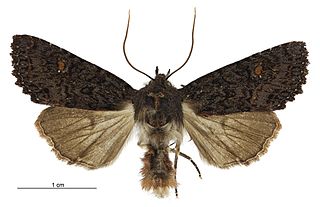
Meterana vitiosa is a moth of the family Noctuidae. It was described by Arthur Gardiner Butler in 1877 from specimens collected by Dr Hector and Mr J. D. Enys in the South Island. It is endemic to New Zealand. The habitat this species prefers consists of forests and shrub-land areas. Adults are on the wing throughout the year.

Ichneutica atristriga is a moth of the family Noctuidae. It is endemic to New Zealand and is found through out the North, South and Stewart Islands. The larval hosts likely include tussock grasses included Poa cita, P. colensoi and Festuca novae-zelandiae. Larvae have been reared on species in the genera Bromus and Festuca. The adults of this species are on the wing from November to May. I. atristriga can possibly be confused with the smaller species I. propria. However I. atristriga has thorax and forewings that have a pinkish tinge and I. propria has a dark streak on the discal part of the forewing which I. atristriga lacks. A study has indicated that the population numbers of this species have decreased.

Meterana praesignis is a species of moth in the family Noctuidae. It was described by George Howes in 1911 from specimens collected in Orepuki in September and November. It is endemic to New Zealand.

Meterana pansicolor is a species of moth in the family Noctuidae. It is endemic to New Zealand. This species is classified as "At Risk, Naturally Uncommon" by the Department of Conservation.

Bityla defigurata is a moth of the family Noctuidae. It is endemic to New Zealand.
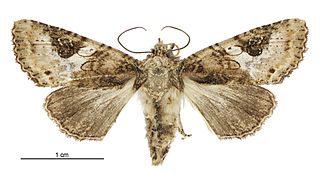
Meterana octans is a species of moth in the family Noctuidae. It was described by George Hudson in 1898 from specimens discovered by Alfred Philpott at Mount Linton, near Invercargill. It is endemic to New Zealand.

Meterana ochthistis is a species of moth in the family Noctuidae. It was described by Edward Meyrick in 1887 from specimens obtained in Christchurch. It is endemic to New Zealand.
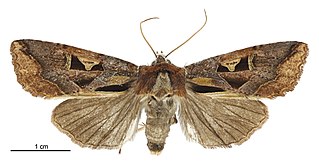
Meterana grandiosa is a species of moth in the family Noctuidae. This species is endemic to New Zealand. It is classified as "At Risk, Relict'" by the Department of Conservation.

Meterana badia is a species of moth in the family Noctuidae. This species is endemic to New Zealand.

Meterana dotata is a species of moth in the family Noctuidae. This species is endemic to New Zealand.




















